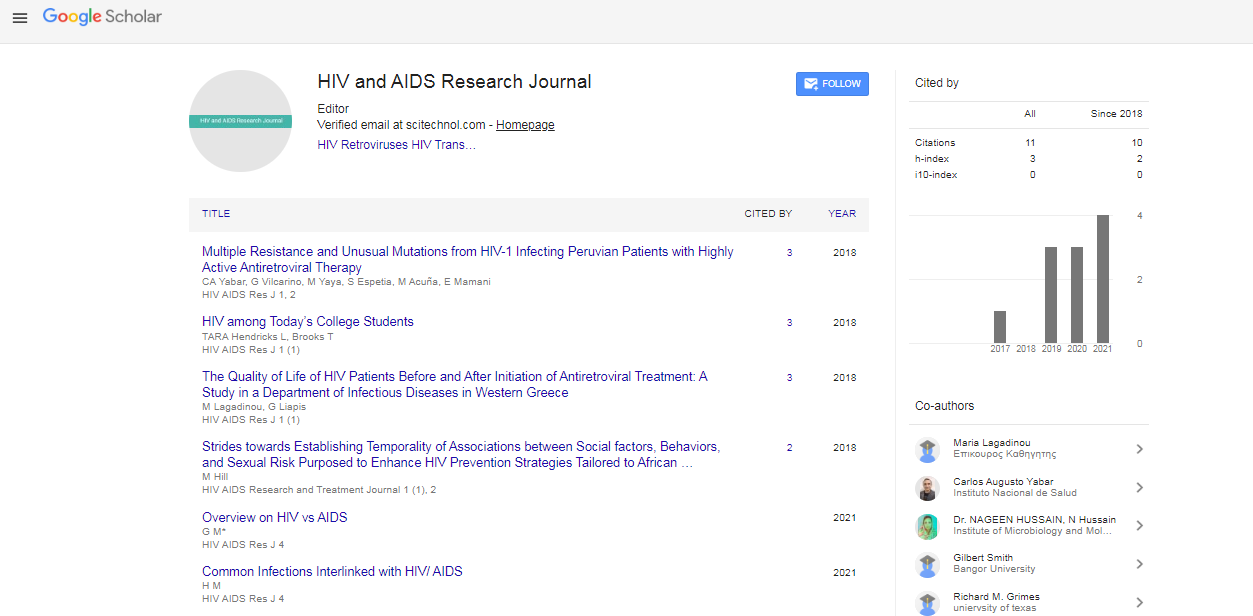Opinion Article, Hiv Aids Res J Vol: 6 Issue: 4
Advanced Strategies in Preventing Advanced HIV Infection
Fredrick Richards*
1Department of Medicine, University of Toronto, Toronto, Canada
*Corresponding Author: Fredrick Richards,
Department of Medicine, University of
Toronto, Toronto, Canada
E-mail: fredrick.richards@gmail.com
Received date: 04 December, 2023, Manuscript No. HARJ-24-124134;
Editor assigned date: 06 December, 2023, PreQC No. HARJ-24-124134 (PQ);
Reviewed date: 20 December, 2023, QC No. HARJ-24-124134;
Revised date: 28 December, 2023, Manuscript No. HARJ-24-124134 (R);
Published date: 05 January, 2024 DOI: 10.4172/Harj.1000138
Citation: Richards F (2024) Advanced Strategies in Preventing Advanced HIV Infection. HIV AIDS Res J 6:4.
Description
As the global fight against Human Immunodeficiency Virus (HIV) continues, preventing the progression of HIV infection to an advanced stage remains pivotal in curbing the HIV/AIDS epidemic. While significant progress has been made in HIV prevention and treatment, late-stage HIV infection poses substantial health risks and challenges.
Current landscape of HIV prevention
Effective prevention strategies, such as condom use, Pre-Exposure Prophylaxis (PrEP), and early Antiretroviral Therapy (ART), have contributed to declining HIV incidence rates. However, preventing advanced HIV infection demands specialized interventions targeting individuals at higher risk or those already diagnosed with HIV.
Biomedical interventions
Pre-Exposure Prophylaxis (PrEP): PrEP involves the use of antiretroviral medications by HIV-negative individuals to prevent HIV acquisition. Tenofovir Disoproxil Fumarate (TDF) are commonly prescribed as a daily oral PrEP regimen, with proven efficacy in reducing HIV transmission among high-risk populations. Ongoing research explores alternative dosing strategies, such as on-demand or long-acting injectable PrEP, to enhance adherence and accessibility.
Post-Exposure Prophylaxis (PEP): PEP involves the use of antiretroviral drugs after potential exposure to HIV to prevent infection. Rapid initiation of PEP within hours to days after exposure significantly reduces the risk of seroconversion. Expanding access to PEP and increasing awareness among populations at risk are crucial to its effectiveness.
Advanced preventive measures
Early diagnosis and immediate treatment initiation: Prompt HIV diagnosis followed by immediate initiation of Antiretroviral Therapy (ART) significantly curtails disease progression. Early treatment not only preserves immune function but also reduces the risk of transmission to uninfected partners.
Treatment as Prevention (TasP): The concept of TasP involves using ART to suppress viral load to undetectable levels, greatly reducing the risk of onward HIV transmission. Implementing TasP at the population level has the potential to curb HIV spread significantly.
Targeted interventions for high-risk populations: Tailored prevention efforts, including enhanced HIV testing, PrEP for at-risk populations, and comprehensive healthcare access, are critical in preventing advanced HIV infection among groups disproportionately affected by the epidemic.
Long-Acting Antiretrovirals (LAARs): Advancements in drug development have led to the exploration of long-acting injectable antiretrovirals, offering extended protection and improved adherence, particularly beneficial for individuals at risk of non-adherence to daily oral medication regimens.
Challenges and opportunities
Despite these advanced strategies, several challenges hinder their widespread implementation:
Access and equity: Ensuring equitable access to advanced preventive measures, especially in resource-limited settings, remains a significant challenge.
Stigma and discrimination: Persistent stigma surrounding HIV/ AIDS can hinder individuals from seeking testing, treatment, or prevention services, affecting the effectiveness of preventive measures.
Health system strengthening: Strengthening healthcare systems to support the delivery of advanced preventive interventions requires sustained investment and infrastructure development.
Potential impact of advanced preventive measures
Implementing these advanced strategies holds immense potential in reducing HIV-related morbidity, mortality, and new infections. Preventing the progression to advanced HIV disease not only improves individual health outcomes but also contributes to the overall reduction of HIV transmission in communities.
Conclusion
Advanced preventive measures targeting late-stage HIV infection represent a crucial frontier in HIV/AIDS prevention. While challenges persist, the implementation of these strategies promises substantial progress in reducing the burden of advanced HIV disease. Continued commitment to research, resource allocation, and community engagement is imperative in realizing the full potential of these advanced preventive measures and altering the trajectory of the HIV/ AIDS epidemic.
 Spanish
Spanish  Chinese
Chinese  Russian
Russian  German
German  French
French  Japanese
Japanese  Portuguese
Portuguese  Hindi
Hindi 